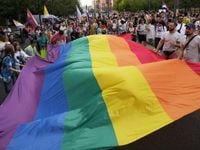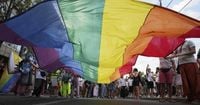On September 6, 2025, the streets of central Belgrade filled with a somber, determined energy as Serbia’s annual Pride march took on a distinctly political tone. Far from the vibrant festival atmosphere that usually marks such events, this year’s march transformed into a protest, with participants condemning police violence against anti-government demonstrators and voicing solidarity with university students who have been at the forefront of a ten-month wave of unrest against President Aleksandar Vucic.
Organizers of the march made their intentions clear from the outset. “We cannot close our eyes at what’s happening in our country,” they said in a statement, according to the Associated Press. The statement cited frequent police brutality and the jailing of protesters, adding, “Pride won’t take part in creating a semblance of normalcy.” This year, the event eschewed festival features in favor of a commemorative silence—a gesture marking the persistence and gravity of the student-led demonstrations that have rocked Serbia since November 2024.
Banners held high in the crowd captured the mood: “Gays against police state!” read one, while another proclaimed “Pump it up!”—the rallying cry of the student movement that has drawn hundreds of thousands into the streets. The Los Angeles Times reported that the march was explicitly intended as a protest, with organizers and attendees united in their call for justice and reform.
The roots of the current unrest trace back to a tragedy that struck Serbia in November 2024. A concrete canopy collapsed at a train station in the northern city of Novi Sad, killing 16 people. The incident quickly became a flashpoint, with demonstrators blaming entrenched corruption and government negligence for the disaster. What began as a demand for a transparent investigation soon evolved into broader calls for anti-corruption measures and, eventually, snap parliamentary elections.
For the first nine months, protests unfolded largely peacefully, but that calm came to an abrupt end in mid-August 2025. Violent clashes erupted between demonstrators and police, culminating in a particularly chaotic night on September 5. Thousands gathered at Novi Sad’s university campus for speeches and a march, only to be met with tear gas and stun grenades from riot police. According to Al Jazeera and the Associated Press, students accused police of launching “brutal attacks on their own citizens.”
The extent of the violence became clear in the aftermath. Interior Minister Ivica Dacic told state media that 13 police officers were injured during what he called a “massive and brutal attack” by demonstrators, while 42 protesters were detained. Dozens of civilians were also hurt as baton-wielding, shielded riot police charged at the crowd, sending many fleeing in panic.
President Aleksandar Vucic, facing mounting pressure from the protest movement, has taken a hardline approach. He has rejected student demands for snap parliamentary elections and intensified the government’s crackdown on dissent. According to reports from the Associated Press and Al Jazeera, Vucic has dismissed scores of professors and teachers, deployed police inside university buildings, and characterized the protesters as a threat to Serbia’s stability and security. “People in Serbia should know that the state is stronger than anyone … that will always be the case,” he declared, defending the government’s response to the unrest.
Despite the tense atmosphere and a history of violent attacks from right-wing extremists targeting Pride events in Serbia, this year’s march passed without incident. Police maintained a strong presence to secure the event, a precaution that, at least for the day, ensured the safety of participants. This marked a notable shift from previous years, when Pride marches in Belgrade were frequently marred by violence and intimidation.
Yet, for Serbia’s LGBTQ+ community, the challenges extend far beyond the events of a single day. As the Los Angeles Times and other outlets have reported, members of this community routinely face harassment and discrimination in what remains a deeply conservative society. While Serbia is formally seeking European Union membership—a process that typically requires progress on human rights issues—the country has made little headway in advancing LGBTQ+ rights. Notably, same-sex partnerships remain unrecognized by law, and legislative reforms have stalled despite repeated calls from activists and international observers.
The intersection of the LGBTQ+ rights movement with the broader struggle for democracy and accountability has become increasingly visible. This year’s Pride organizers explicitly linked their cause to the fight against state violence and government overreach, standing in solidarity with student protesters and other victims of repression. “Pride won’t take part in creating a semblance of normalcy,” they insisted, emphasizing that their participation in the march was as much about resisting authoritarianism as it was about celebrating identity.
Observers say the unity displayed between the LGBTQ+ community and the student protest movement signals a shift in Serbian civil society. The lines between different struggles—whether for minority rights, academic freedom, or political accountability—are blurring, as diverse groups find common cause in their opposition to the current government’s tactics.
Still, the path forward remains uncertain. President Vucic’s refusal to concede to protester demands, combined with the government’s willingness to deploy force against demonstrators, has left many Serbians anxious about the country’s political trajectory. The government’s insistence on maintaining order, even at the cost of civil liberties, has drawn criticism from both domestic and international observers, who warn that such measures risk deepening divisions and eroding trust in public institutions.
For now, the Pride marchers and student protesters remain undeterred. Their banners, chants, and moments of silence are a reminder that the fight for rights and justice in Serbia is far from over. As the country continues to grapple with its future, the events of September 6 stand as a testament to the resilience—and the defiance—of those determined to make their voices heard, no matter the obstacles.
The story of Serbia’s 2025 Pride march is not just about a single protest or a single community. It’s about the collision of movements, the persistence of hope, and the ongoing struggle for a more open and just society—one where no one is forced to choose between safety and self-expression.



